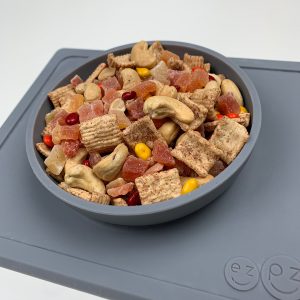How to Safely Introduce Apple to Your Baby

Pediatric feeding & swallowing therapists (like myself) encourage parents not to feed raw apples to babies & young children due to their high choking risk. The general media has also embraced this feeding education; for example, the New York Times ranks apples as one of the “10 Biggest choking hazards”. So how should parents introduce an apple to their baby safely? Glad you asked! 😀 Below, I’ve outlined my expert feeding tips to avoid choking risks while helping you discover ways your baby can enjoy this beloved fruit!
Choking Concerns
Research shows that raw apples are among the most dangerous foods unintentionally offered to babies by their caregivers.
Risks
Raw apples are considered dangerous due to their hard, crunchy texture. But don’t let the risk scare you into only offering commercial applesauce or avoiding apples altogether! In fact, research shows that the highest frequency of choking occurs among babies who were given finger foods the least often. So, if you feel more comfortable starting with thick apple puree (applesauce), that’s fine – just don’t get stuck on that texture. Keep reading for my other consistencies and textures!
Textures
Yes, a raw apple is a choking risk, but you can provide your little one with an apple in another, safer texture. Here are a few of my favorite ways to serve apples to your baby.
Cooked
Apples can be cooked to soften their texture. You will know that it’s cooked enough when you press the apple slice between your index finger and thumb and feel that it is flexible enough for baby to munch on with their gums. You read that right; babies do not need teeth in order to eat soft foods like cooked apples. Instead, they use the pressure from their gums to break food down, which is why caregivers need to provide pliable textures.
Lumpy Puree
You can make homemade applesauce by blending cooked apples in your food processor for a few minutes. This lumpy puree is a great texture to put on a baby-led spoon (like the Tiny Spoon) to practice self-feeding skills. This puree practice will help baby achieve their spoon-feeding milestones.
Thin Puree
You can offer your baby a thin puree by placing the cooked apple slices in a blender with an ounce of breastmilk or formula. Then place the thin puree into a baby-led cup such as the Tiny Cup so baby can work on their open-cup drinking milestone.
Grated
I like to grate apples and offer them as a “sprinkle” for babies. First, I remove the skin and seeds. Then I grate the flesh and sprinkle a small amount over yogurt, pancakes, waffles, or oatmeal. A grated apple is a fun, sweet, and safe texture for baby to try!
Liquids
The American Academy of Pediatrics (“AAP”) does not recommend apple juice for children under one year of age due to obesity and dental health concerns. So please avoid offering your baby apple juice or apple cider.
Shapes + Spices
Did you know that changing the shape or taste of a baby’s food can help decrease choking risk? Yes! Different shapes, tastes, and textures can help develop critical oral-motor skills that will aid in chewing and swallowing safely!
Shapes
Avoid offering cooked apples cut in half because it can lead to overstuffing and therefore poses a choking risk. Ideally, you want to provide cooked apples cut to the length of your pinky finger and thinly sliced (see image above). I like to use a crinkle cutter on the edges of the cooked apple. This provides additional texture that can help a baby’s tongue push the apple onto the gumline. The grooves of the crinkle cutter also allow the baby to have a better grip (cooked apples can be a bit slippery).
Spices
Feel free to add some spices such as cinnamon or nutmeg. Adding spices will enhance the sensory properties of the apple and allow your baby to find the food pieces more easily in their mouth. This sensory tip also helps decrease choking risk.
How do you prepare apples for your baby? What are some of your baby’s favorite spices?
P.S. Get more tools for starting solids and gifts for your baby in my Amazon Store!





